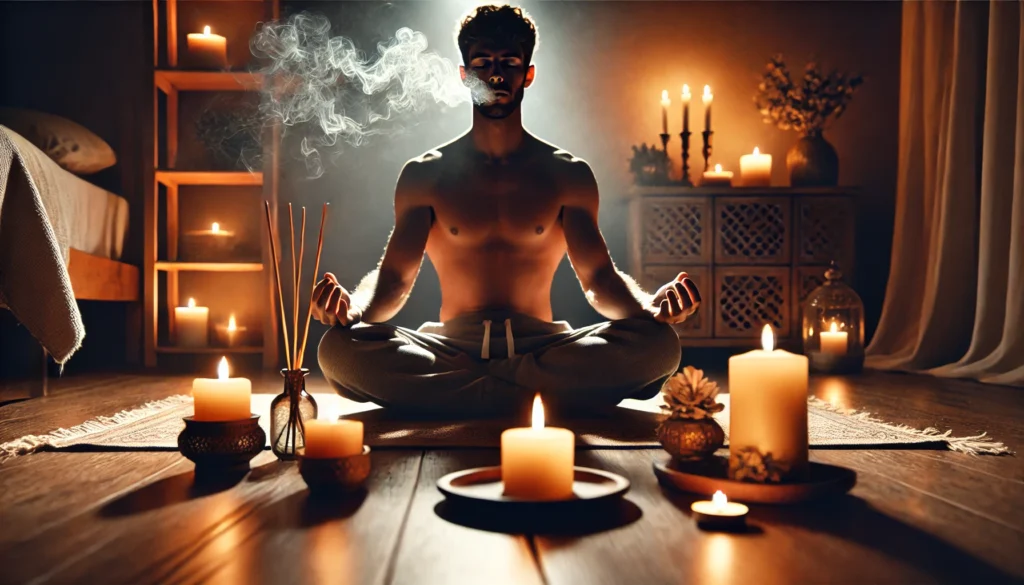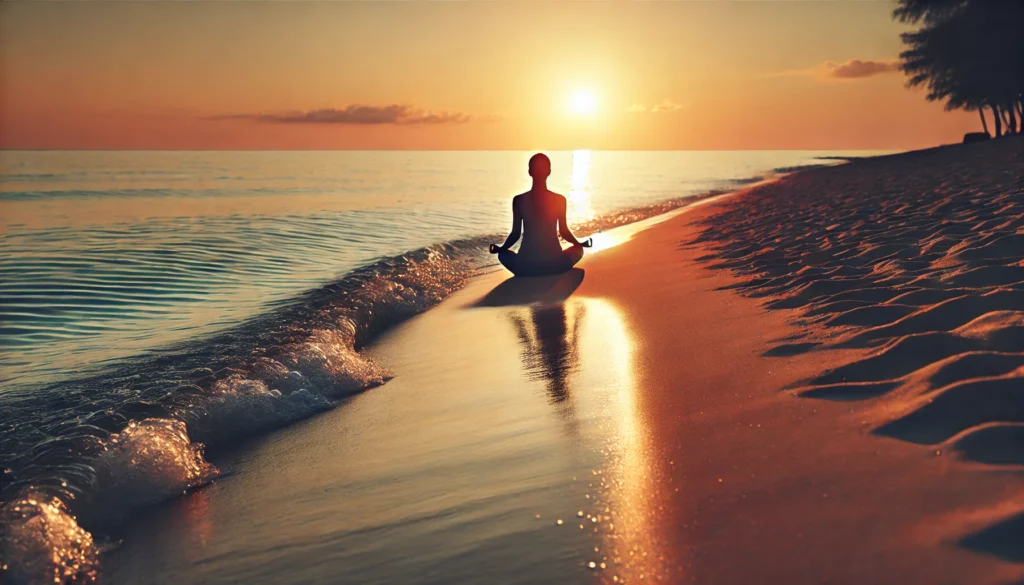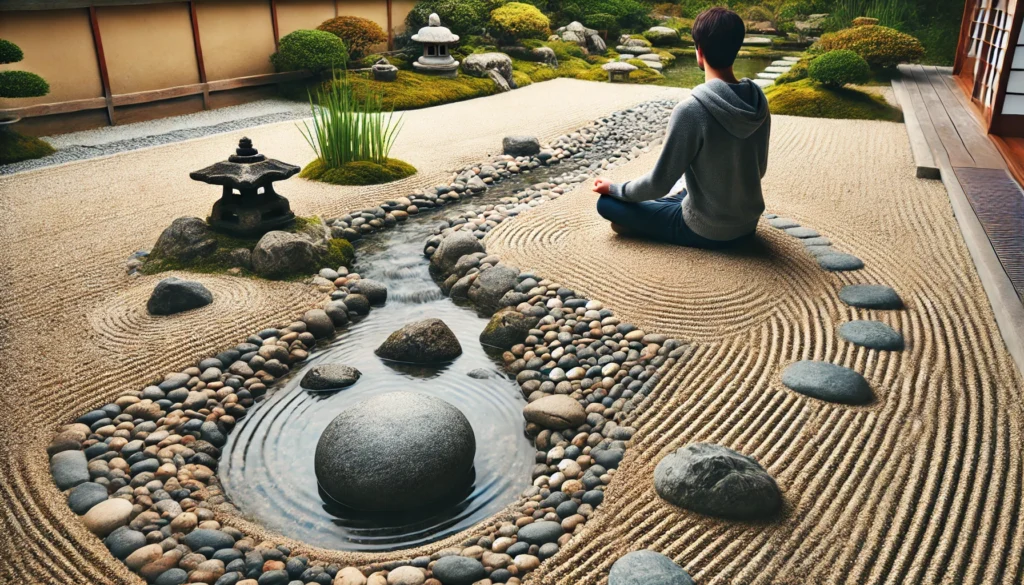Calm meditation is a practice that encourages a state of tranquility and relaxation. Unlike more vigorous forms of meditation, such as dynamic or movement-based practices, calm meditation focuses on stillness and mindfulness. This gentle approach allows practitioners to connect with their inner selves, fostering peace and clarity.
You may also like: Effective Stress Management Techniques for Daily Life
Understanding Calm Meditation
At its core, calm meditation is about embracing stillness and presence. This form of meditation encourages you to slow down and become aware of your thoughts and feelings without judgment. By sitting quietly and focusing on your breath or a specific mantra, you enter a meditative state that promotes relaxation and mental clarity. The practice is accessible to everyone, irrespective of age or fitness level, and can be adapted to suit personal preferences.
Differentiating from Other Meditation Practices
Calm meditation stands apart from other practices like dynamic meditation or yoga-based meditation due to its emphasis on quietude. While other forms may involve physical movement or vigorous breathing, calm meditation invites you to be still and observe your mind’s activity. This focus on tranquility can be particularly beneficial for those seeking to reduce stress and find inner peace in a hectic world.
Benefits of Embracing Stillness
Engaging in calm meditation can significantly impact your mental and physical health. It allows you to detach from daily stressors, leading to a reduction in anxiety and depression. Additionally, this practice can improve sleep quality, increase focus, and enhance emotional regulation. By regularly incorporating calm meditation into your routine, you cultivate a more balanced, peaceful mindset that can transform how you navigate life’s challenges.
Historical Context and Evolution
The roots of meditation can be traced back thousands of years to ancient civilizations, including India and China. Historically, meditation was intertwined with spiritual and religious practices, such as Buddhism and Hinduism. These traditions viewed meditation as a path to enlightenment and inner peace.
Ancient Origins and Practices
The earliest records of meditation come from Hindu traditions in India, where it was practiced as a method of achieving spiritual insight and harmony. Similarly, in China, meditation was integral to Taoist rituals, emphasizing balance and the flow of life energy. These ancient practices laid the groundwork for the development of diverse meditation techniques that spread across the globe.
Meditation in Religious Contexts
For centuries, meditation has been a cornerstone of various religious practices. In Buddhism, meditation is a fundamental component of the path to enlightenment, helping practitioners cultivate mindfulness and compassion. Meanwhile, in Hinduism, meditation is a means of connecting with the divine and achieving self-realization. These spiritual roots highlight meditation’s profound role in fostering inner peace and spiritual growth.
Modern Adaptations and Global Spread
As meditation evolved over time, it transcended its religious origins and gained popularity as a secular practice. The 20th century saw meditation’s expansion into the Western world, where it was adopted for its mental health benefits. Today, meditation is practiced globally, with diverse forms tailored to meet the needs of individuals from all walks of life. Its widespread adoption underscores its universal appeal and transformative potential.
The Science Behind Calm Meditation
Research has shown that calm meditation can have profound effects on the brain and body. It activates the parasympathetic nervous system, often referred to as the “rest and digest” system, which counteracts the body’s stress response. This physiological shift can reduce heart rate, lower blood pressure, and decrease cortisol levels, leading to a calmer state of being.
Physiological Impact of Meditation
When you engage in calm meditation, your body’s physiological responses begin to change. The activation of the parasympathetic nervous system induces a state of relaxation, slowing down your heart rate and reducing blood pressure. This shift helps counteract the “fight or flight” response triggered by stress, allowing you to experience a sense of calm and tranquility.
Brain Changes and Neuroplasticity
Neuroscientific research has demonstrated that regular meditation can lead to changes in brain structure and function. Studies have shown increased gray matter density in areas associated with memory, learning, and emotional regulation. This neuroplasticity enhances cognitive function and emotional resilience, empowering individuals to handle stress more effectively.
Psychological Benefits and Emotional Well-being
Calm meditation not only impacts your physical health but also plays a crucial role in emotional well-being. By fostering mindfulness and present-moment awareness, meditation can reduce symptoms of anxiety and depression. Practitioners often report improved mood, greater self-awareness, and a more positive outlook on life. These psychological benefits contribute to a more balanced and fulfilling existence.
Exploring Different Forms of Calm Meditation
The beauty of calm meditation lies in its versatility. There are several forms of meditation that can be adapted to suit individual preferences and lifestyles. Here are a few popular variations:
The Daily Calm
The Daily Calm is a structured approach to meditation that encourages practitioners to dedicate a specific time each day to their practice. This consistency helps to establish a routine, making it easier to integrate meditation into one’s daily life. The Daily Calm can involve guided meditations, silent contemplation, or a combination of both.
Establishing a Daily Routine
Creating a daily meditation routine is key to reaping the benefits of calm meditation. Start by choosing a time of day that works best for you, whether it’s morning, midday, or evening. Consistency is crucial, so aim to meditate at the same time each day. This routine helps train your mind to enter a meditative state more easily, enhancing the overall effectiveness of your practice.

Guided vs. Silent Meditation
The Daily Calm can be practiced through guided or silent meditation. Guided sessions, often available through apps or online platforms, provide instructions and support, making them ideal for beginners. Silent meditation, on the other hand, allows for introspection and self-guidance, offering a more personalized experience. Experiment with both to find what resonates with you.
Overcoming Common Challenges
While establishing a daily practice, you may encounter challenges such as restlessness or a wandering mind. Acknowledge these distractions without judgment and gently redirect your focus to your breath or chosen point of concentration. With time and patience, these challenges will diminish, allowing you to deepen your practice and experience greater calm.
Calm Ease Meditation
Calm Ease Meditation is a technique that emphasizes breathing and mindfulness to promote relaxation. This practice encourages individuals to focus on their breath, observing each inhalation and exhalation without judgment. By cultivating awareness of the present moment, practitioners can release tension and achieve a state of calm ease.
The Importance of Breath Awareness
Breath awareness is a cornerstone of Calm Ease Meditation. By focusing on the natural rhythm of your breath, you anchor yourself in the present moment, reducing stress and anxiety. This mindful breathing technique helps quiet the mind and create a sense of inner peace, making it an effective tool for relaxation.
Techniques for Enhancing Mindfulness
To enhance mindfulness during Calm Ease Meditation, consider incorporating techniques such as body scanning or loving-kindness meditation. Body scanning involves directing your attention to different parts of your body, promoting relaxation and awareness. Loving-kindness meditation fosters compassion by encouraging you to send positive intentions to yourself and others.
Integrating Calm Ease into Daily Life
Calm Ease Meditation can be seamlessly integrated into your daily routine. Practice mindful breathing during everyday activities, such as walking or eating, to cultivate presence and awareness. By incorporating mindfulness into your daily life, you create a foundation for calm and tranquility that extends beyond formal meditation sessions.
Stress Relief Meditation
Stress relief meditation is specifically designed to address the physical and mental effects of stress. This practice often incorporates visualization techniques, where individuals imagine themselves in a peaceful setting or visualize stress melting away with each breath. By engaging the mind in this way, stress relief meditation can significantly reduce anxiety and promote relaxation.
Visualization Techniques for Stress Reduction
Visualization is a powerful tool for stress relief meditation. Begin by imagining a serene environment, such as a beach or forest, and immerse yourself in the sights, sounds, and sensations of this peaceful setting. This mental imagery can distract from stressors and induce relaxation, offering a respite from the demands of daily life.
Combining Breathwork and Visualization
To enhance the effectiveness of stress relief meditation, combine visualization with breathwork. As you visualize stress melting away with each exhalation, consciously slow your breath to promote relaxation. This combination of techniques engages both the mind and body, creating a holistic approach to stress reduction.
Cultivating a Stress-Free Mindset
Beyond formal meditation sessions, cultivate a stress-free mindset by adopting practices that promote relaxation and well-being. Consider activities such as yoga, journaling, or spending time in nature to complement your meditation practice. By nurturing a stress-free lifestyle, you enhance the benefits of meditation and foster a greater sense of peace.
Practical Tips for Incorporating Calm Meditation into Your Life
Incorporating calm meditation into your daily routine doesn’t require drastic lifestyle changes. Here are some practical tips to help you get started:
Create a Dedicated Space
Having a designated space for meditation can enhance your practice. Choose a quiet, comfortable area in your home where you can meditate without distractions. Consider adding elements like cushions, candles, or calming music to create a serene atmosphere.
Designing Your Meditation Space
When creating a meditation space, focus on simplicity and comfort. Choose a quiet corner of your home where you can sit without interruptions. Add elements that promote relaxation, such as soft lighting, plants, or soothing sounds. This dedicated space serves as a sanctuary for your practice, helping you enter a meditative state more easily.
Personalizing Your Meditation Environment
Personalize your meditation space with items that hold significance for you. This could include meaningful objects like crystals, artwork, or photographs. The goal is to create an environment that reflects your personal style and supports your meditation journey. A personalized space can enhance your connection to the practice and make meditation more enjoyable.
Maintaining a Clutter-Free Zone
To foster a sense of calm, keep your meditation space clutter-free. Remove unnecessary items and maintain cleanliness to create an environment conducive to relaxation. A tidy space not only enhances focus but also symbolizes a clear mind, allowing you to fully immerse yourself in your meditation practice.
Start Small
If you’re new to meditation, start with short sessions of 5 to 10 minutes and gradually increase the duration as you become more comfortable. Remember, the goal is consistency, not perfection.
Setting Realistic Goals
When beginning your meditation practice, set realistic goals that align with your lifestyle. Start with short, manageable sessions to build confidence and establish a routine. As you become more comfortable, gradually increase the duration and frequency of your practice. Remember, meditation is a journey, and every step forward is a success.

Embracing the Learning Process
Meditation is a skill that takes time to develop. Embrace the learning process and approach your practice with patience and curiosity. Allow yourself to explore different techniques and find what resonates with you. By maintaining an open mind, you’ll discover the unique benefits that meditation can bring to your life.
Celebrating Progress and Milestones
Celebrate your progress and milestones, no matter how small. Whether it’s meditating for a longer period or experiencing a moment of clarity, acknowledge your achievements. These celebrations reinforce your commitment to the practice and motivate you to continue on your meditation journey.
Use Guided Meditations
For beginners, guided meditations can be an excellent resource. There are numerous apps and online platforms, such as Headspace and Calm, that offer a variety of guided sessions tailored to different needs and preferences.
Exploring Various Platforms
Explore different platforms to find guided meditations that suit your preferences. Popular apps like Headspace, Calm, and Insight Timer offer a wide range of sessions, from beginner-friendly introductions to advanced practices. Experiment with different guides and styles to discover what resonates with you and supports your meditation goals.
Customizing Your Meditation Experience
Guided meditations can be customized to address specific needs, such as stress reduction, sleep enhancement, or emotional healing. Choose sessions that align with your intentions and explore different themes to deepen your practice. Customizing your meditation experience ensures that it remains relevant and impactful.
Transitioning to Independent Practice
As you gain confidence, consider transitioning from guided to independent meditation. This shift allows for greater introspection and self-discovery, enabling you to develop a personal meditation practice. Use guided sessions as a foundation and gradually incorporate silent or self-guided meditation to explore new depths of awareness.
Be Patient with Yourself
Meditation is a skill that takes time to develop. Be patient with yourself and approach your practice with a sense of curiosity and openness. Over time, you’ll likely notice improvements in your ability to focus and relax.
Cultivating a Mindful Attitude
Approach your meditation practice with a mindful attitude, focusing on the present moment rather than worrying about the outcome. Let go of expectations and judgments, allowing yourself to experience meditation as it unfolds. This mindset fosters acceptance and encourages a deeper connection to the practice.
Embracing Imperfection
Embrace the imperfections and challenges that arise during meditation. It’s natural for the mind to wander or for distractions to occur. Instead of becoming frustrated, view these moments as opportunities for growth and learning. By accepting imperfections, you cultivate resilience and patience in your practice.
Reflecting on Personal Growth
Take time to reflect on your personal growth and the impact of meditation on your life. Consider keeping a journal to document your experiences, insights, and changes. This reflection not only reinforces your commitment to the practice but also highlights the positive transformations that meditation brings.
The Future of Calm Meditation
As interest in mental health and wellness continues to grow, calm meditation is poised to become an integral part of modern life. Advances in technology, such as virtual reality and biofeedback, are making meditation more accessible and personalized than ever before. These innovations allow individuals to tailor their practice to their unique needs, enhancing the overall effectiveness of meditation as a tool for well-being.
Innovations in Meditation Technology
The future of calm meditation is being shaped by technological innovations that enhance accessibility and personalization. Virtual reality (VR) offers immersive meditation experiences, transporting users to serene environments that enhance relaxation. Biofeedback devices provide real-time data on physiological responses, allowing users to fine-tune their practice for optimal results.
Meditation’s Role in Mental Health
As awareness of mental health issues grows, meditation is increasingly recognized as a valuable tool for emotional well-being. Research continues to explore meditation’s potential in treating conditions such as anxiety, depression, and post-traumatic stress disorder. As meditation becomes more integrated into healthcare, its role in mental health is likely to expand, offering new possibilities for healing and resilience.
Global Trends and Cultural Integration
Meditation is becoming a global phenomenon, embraced by diverse cultures and communities. As it spreads, meditation is being adapted to align with various cultural values and traditions. This cultural integration enriches the practice, fostering cross-cultural understanding and promoting peace on a global scale. The future of meditation holds the promise of a more connected and harmonious world.

Conclusion
Calm meditation offers a pathway to inner peace and resilience in the face of life’s challenges. By understanding its historical roots, scientific underpinnings, and practical applications, you can harness the power of meditation to improve your mental and emotional health. Whether you’re a seasoned practitioner or new to the world of meditation, embracing the practice of calm meditation can lead to profound personal transformation.
Remember, the journey to inner peace is a personal one, and calm meditation is but one of many tools at your disposal. Explore, experiment, and find what works best for you, and in doing so, cultivate a life filled with tranquility and balance. As you embark on this journey, know that each step brings you closer to a deeper understanding of yourself and the world around you.
Further Reading:
14 best mindfulness apps to help you keep calm during a crisis
Meditation: A simple, fast way to reduce stress
Important Note: The information contained in this article is for general informational purposes only, and should not be construed as health or medical advice, nor is it intended to diagnose, prevent, treat, or cure any disease or health condition. Before embarking on any diet, fitness regimen, or program of nutritional supplementation, it is advisable to consult your healthcare professional in order to determine its safety and probable efficacy in terms of your individual state of health.
Regarding Nutritional Supplements Or Other Non-Prescription Health Products: If any nutritional supplements or other non-prescription health products are mentioned in the foregoing article, any claims or statements made about them have not been evaluated by the U.S. Food and Drug Administration, and such nutritional supplements or other health products are not intended to diagnose, treat, cure, or prevent any disease.


